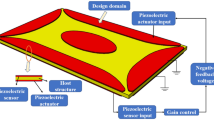Abstract
Based on the bidirectional evolutionary structural optimization method, a robust topology optimization (RTO) algorithm is developed for actuator-coupled structures with hybrid uncertainties. The hybrid interval random variables model is adopted to simulate the uncertainty of the mechanical and piezoelectric parameters. The worst case of the compliance is set as the robust objective function. A hybrid uncertainty perturbation analysis method (HUPAM) is proposed to estimate the expectation and standard variance of the robust objective function. The density-based interpolation scheme is employed to establish the design variables, and the sensitivity of the robust objective function with respect to the design variables is derived. The robust topologies of the host structure and the optimal placement of the coupled actuators are obtained by the proposed RTO approach. Several numerical examples are presented to show the effectiveness of the proposed method, and the Monte Carlo method is used to validate the accuracy of the HUPAM.











Similar content being viewed by others
References
Aridogan, U., Basdogan, I.: A review of active vibration and noise suppression of plate-like structures with piezoelectric transducers. J. Intell. Mater. Syst. Struct. 26(14), 1455–1476 (2015). https://doi.org/10.1177/1045389X15585896
Wang, X., Zhou, J., Song, J., Liu, J., Xu, N., Wang, Z.L.: Piezoelectric field effect transistor and nanoforce sensor based on a single ZnO nanowire. Nano Lett. 6(14), 2768–2772 (2006). https://doi.org/10.1021/nl061802g
Koconis, D.B., Kollar, L.P., Springer, G.S.: Shape control of composite plates and shells with embedded actuators. II. Desired shape specified. J. Compos. Mater. 28(3), 262–285 (1994). https://doi.org/10.1177/002199839402800305
Kim, H.S., Kim, J.-H., Kim, J.: A review of piezoelectric energy harvesting based on vibration. Int. J. Precis. Eng. Manuf. 12(6), 1129–1141 (2011). https://doi.org/10.1007/s12541-011-0151-3
Zhang, X., Takezawa, A., Kang, Z.: Topology optimization of piezoelectric smart structures for minimum energy consumption under active control. Struct. Multidiscip. Optim. 58(1), 185–199 (2018). https://doi.org/10.1007/s00158-017-1886-y
Molter, A., Fonseca, J.S.O., Fernandez, LdS: Simultaneous topology optimization of structure and piezoelectric actuators distribution. Appl. Math. Model. 40(11), 5576–5588 (2016). https://doi.org/10.1016/j.apm.2016.01.023
Li, C., Ding, Y., Gu, G., Zhu, L.: Damping control of piezo-actuated nanopositioning stages with recursive delayed position feedback. IEEE/ASME Trans. Mechatron. 22(2), 855–864 (2017). https://doi.org/10.1109/TMECH.2016.2639584
Bendsoe, M., Sigmund, O.: Topology Optimization-Theory, Methods and Applications. Springer, Berlin (2003)
Bendsøe, M.P., Kikuchi, N.: Generating optimal topologies in structural design using a homogenization method. Comput. Methods Appl. Mech. Eng. 71(2), 197–224 (1988). https://doi.org/10.1016/0045-7825(88)90086-2
Xie, Y.M., Steven, G.P.: A simple evolutionary procedure for structural optimization. Comput. Struct. 49(5), 885–896 (1993). https://doi.org/10.1016/0045-7949(93)90035-C
Bendsøe, M.P., Sigmund, O.: Material interpolation schemes in topology optimization. Arch. Appl. Mech. 69(11), 635–654 (1999). https://doi.org/10.1007/s004190050248
Wang, M.Y., Wang, X., Guo, D.: A level set method for structural topology optimization. Comput. Methods Appl. Mech. Eng. 192(1), 227–246 (2003). https://doi.org/10.1016/S0045-7825(02)00559-5
He, Z.C., Zhang, G.Y., Deng, L., Li, E., Liu, G.R.: Topology optimization using node-based smoothed finite element method. Int. J. Appl. Mech. 07(06), 1550085 (2015). https://doi.org/10.1142/S1758825115500854
Luo, Z., Tong, L., Wang, M.Y., Wang, S.: Shape and topology optimization of compliant mechanisms using a parameterization level set method. J. Comput. Phys. 227(1), 680–705 (2007). https://doi.org/10.1016/j.jcp.2007.08.011
Wu, J., Luo, Z., Li, H., Zhang, N.: Level-set topology optimization for mechanical metamaterials under hybrid uncertainties. Comput. Method Appl. Mech. Eng. 319, 414–441 (2017). https://doi.org/10.1016/j.cma.2017.03.002
Nasser, H., Porn, S., Koutsawa, Y., Giunta, G., Belouettar, S.: Optimal design of a multilayered piezoelectric transducer based on a special unit cell homogenization method. Acta Mech. 227(9), 1837–1847 (2016). https://doi.org/10.1007/s00707-016-1581-x
Martin, K., Emílio, C.N.S.: Topology optimization of smart structures: design of piezoelectric plate and shell actuators. Smart Mater. Struct. 14(2), 387 (2005)
Ronny, C.C., Emílio, C.N.S., Shinji, N.: Optimum placement of piezoelectric material in piezoactuator design. Smart Mater. Struct. 16(1), 207 (2007)
Zheng, B., Chang, C.-J., Gea, H.C.: Topology optimization of energy harvesting devices using piezoelectric materials. Struct. Multidiscip. Optim. 38(1), 17–23 (2009). https://doi.org/10.1007/s00158-008-0265-0
Kang, Z., Wang, R., Tong, L.: Combined optimization of bi-material structural layout and voltage distribution for in-plane piezoelectric actuation. Comput. Methods Appl. Mech. Eng. 200(15), 1467–1478 (2011). https://doi.org/10.1016/j.cma.2011.01.005
Yiqiang, W., Zhen, L., Xiaopeng, Z., Zhan, K.: Topological design of compliant smart structures with embedded movable actuators. Smart Mater. Struct. 23(4), 045024 (2014)
Schuëller, G.I., Jensen, H.A.: Computational methods in optimization considering uncertainties—an overview. Comput. Methods Appl. Mech. Eng. 198(1), 2–13 (2008). https://doi.org/10.1016/j.cma.2008.05.004
Wang, L., Xiong, C., Wang, X., Liu, G., Shi, Q.: Sequential optimization and fuzzy reliability analysis for multidisciplinary systems. Struct. Multidiscip. Optim. 60(3), 1079–1095 (2019). https://doi.org/10.1007/s00158-019-02258-y
Ghanem, R., Red-Horse, J.: Propagation of probabilistic uncertainty in complex physical systems using a stochastic finite element approach. Physica D 133(1), 137–144 (1999). https://doi.org/10.1016/S0167-2789(99)00102-5
Stefanou, G., Savvas, D., Papadrakakis, M.: Stochastic finite element analysis of composite structures based on mesoscale random fields of material properties. Comput. Methods Appl. Mech. Eng. 326, 319–337 (2017). https://doi.org/10.1016/j.cma.2017.08.002
Massa, F., Tison, T., Lallemand, B.: A fuzzy procedure for the static design of imprecise structures. Comput. Methods Appl. Mech. Eng. 195(11), 925–941 (2006). https://doi.org/10.1016/j.cma.2005.02.015
Wang, L., Wang, X., Xia, Y.: Hybrid reliability analysis of structures with multi-source uncertainties. Acta Mech. 225(2), 413–430 (2014). https://doi.org/10.1007/s00707-013-0969-0
Jiang, C., Zhang, Q.F., Han, X., Qian, Y.H.: A non-probabilistic structural reliability analysis method based on a multidimensional parallelepiped convex model. Acta Mech. 225(2), 383–395 (2014). https://doi.org/10.1007/s00707-013-0975-2
Jiang, C., Liu, N.Y., Ni, B.Y.: A Monte Carlo simulation method for non-random vibration analysis. Acta Mech. 228(9), 2631–2653 (2017). https://doi.org/10.1007/s00707-017-1842-3
Wang, L., Xia, H., Zhang, X., Lv, Z.: Non-probabilistic reliability-based topology optimization of continuum structures considering local stiffness and strength failure. Comput. Methods Appl. Mech. Eng. 346, 788–809 (2019). https://doi.org/10.1016/j.cma.2018.09.021
Jiang, C., Zheng, J., Han, X.: Probability-interval hybrid uncertainty analysis for structures with both aleatory and epistemic uncertainties: a review. Struct. Multidiscip. Optim. 57(6), 2485–2502 (2018). https://doi.org/10.1007/s00158-017-1864-4
He, Z.C., Wu, Y., Li, E.: Topology optimization of structure for dynamic properties considering hybrid uncertain parameters. Struct. Multidiscip. Optim. 57(2), 625–638 (2018). https://doi.org/10.1007/s00158-017-1769-2
Wu, J., Luo, Z., Li, H., Zhang, N.: A new hybrid uncertainty optimization method for structures using orthogonal series expansion. Appl. Math. Model. 45, 474–490 (2017)
Farrokh, M., Azar, A., Jandaghi, G., Ahmadi, E.: A novel robust fuzzy stochastic programming for closed loop supply chain network design under hybrid uncertainty. Fuzzy Sets Syst. 341, 69–91 (2018). https://doi.org/10.1016/j.fss.2017.03.019
Wu, D., Gao, W.: Hybrid uncertain static analysis with random and interval fields. Comput. Methods Appl. Mech. Eng. 315, 222–246 (2017)
Xia, B., Yu, D.: An interval random perturbation method for structural-acoustic system with hybrid uncertain parameters. Int. J. Numer. Methods Eng. 97(3), 181–206 (2013). https://doi.org/10.1002/nme.4585
Xia, B., Yu, D., Han, X., Jiang, C.: Unified response probability distribution analysis of two hybrid uncertain acoustic fields. Comput. Methods Appl. Mech. Eng. 276(9), 20–34 (2014)
Kharmanda, G., Olhoff, N., Mohamed, A., Lemaire, M.: Reliability-based topology optimization. Struct. Multidiscip. Optim. 26(5), 295–307 (2004)
Kang, Z., Luo, Y.: Non-probabilistic reliability-based topology optimization of geometrically nonlinear structures using convex models. Comput. Methods Appl. Mech. Eng. 198(57), 3228–3238 (2009). https://doi.org/10.1016/j.cma.2009.06.001
Zheng, J., Luo, Z., Jiang, C., Ni, B., Wu, J.: Non-probabilistic reliability-based topology optimization with multidimensional parallelepiped convex model. Struct. Multidiscip. Optim. 57(6), 2205–2221 (2018)
Wang, L., Liu, D., Yang, Y., Hu, J.: Novel methodology of non-probabilistic reliability-based topology optimization (NRBTO) for multi-material layout design via interval and convex mixed uncertainties. Comput. Methods Appl. Mech. Eng. 346, 550–573 (2019). https://doi.org/10.1016/j.cma.2018.11.035
Jalalpour, M., Tootkaboni, M.: An efficient approach to reliability-based topology optimization for continua under material uncertainty. Struct. Multidiscip. Optim. 53(4), 759–772 (2016)
Wang, L., Liu, D., Yang, Y., Wang, X., Qiu, Z.: A novel method of non-probabilistic reliability-based topology optimization corresponding to continuum structures with unknown but bounded uncertainties. Comput. Methods Appl. Mech. Eng. 326, 573–595 (2017). https://doi.org/10.1016/j.cma.2017.08.023
Dunning, P.D., Kim, H.A.: Robust topology optimization: minimization of expected and variance of compliance. AIAA J. 51(13), 2656–2664 (2013). https://doi.org/10.2514/1.J052183
Jansen, M., Lombaert, G., Diehl, M., Lazarov, B.S., Sigmund, O., Schevenels, M.: Robust topology optimization accounting for misplacement of material. Struct. Multidiscip. Optim. 47(3), 317–333 (2013). https://doi.org/10.1007/s00158-012-0835-z
Wu, J., Gao, J., Luo, Z., Brown, T.: Robust topology optimization for structures under interval uncertainty. Adv. Eng. Softw. 99, 36–48 (2016). https://doi.org/10.1016/j.advengsoft.2016.05.002
Chen, N., Yu, D., Xia, B., Ma, Z.: Topology optimization of structures with interval random parameters. Comput. Methods Appl. Mech. Eng. 307, 300–315 (2016)
Zheng, J., Luo, Z., Jiang, C., Gao, J.: Robust topology optimization for concurrent design of dynamic structures under hybrid uncertainties. Mech. Syst. Signal Process. 120, 540–559 (2019)
Haug, E., Choi, K., Komkov, V.: Design Sensitivity Analysis of Structural Systems. Academic Press, Cambridge (1986)
Sigmund, O., Petersson, J.: Numerical instabilities in topology optimization: a survey on procedures dealing with checkerboards, mesh-dependencies and local minima. Struct. Optim. 16(1), 68–75 (1998). https://doi.org/10.1007/BF01214002
Huang, X., Xie, Y.M.: Convergent and mesh-independent solutions for the bi-directional evolutionary structural optimization method. Finite Elem. Anal. Des. 43(16), 1039–1049 (2007). https://doi.org/10.1016/j.finel.2007.06.006
Acknowledgements
This work was supported by the National Key R&D Program of China (2016YFB0100903-2, the Foundation for Innovative Research Groups of the National Natural Science Foundation of China (Grant No. 51621004), the Opening Project of the Guangxi Key Laboratory of Automobile Components and Vehicle Technology of Guangxi University of Science and Technology (No. 2017GKLACVTKF01) and the Opening Project of the Hunan Provincial Key Laboratory of Vehicle Power and Transmission System (Nos. VPTS-2019-02, VPTS-2019-03 and VPTS-2019-06), Natural Science Foundation of Hunan Province (Grant No. 2017JJ3030). In addition, the authors thank the reviewers for their constructive comments.
Author information
Authors and Affiliations
Corresponding author
Additional information
Publisher's Note
Springer Nature remains neutral with regard to jurisdictional claims in published maps and institutional affiliations.
Rights and permissions
About this article
Cite this article
He, Z.C., Jiang, H.X., Wu, Y. et al. Robust topological design of actuator-coupled structures with hybrid uncertainties. Acta Mech 231, 1621–1638 (2020). https://doi.org/10.1007/s00707-019-02608-3
Received:
Revised:
Published:
Issue Date:
DOI: https://doi.org/10.1007/s00707-019-02608-3




